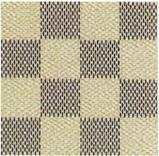Vuitton bags a victory
But a further decision is still in the works, reports Maria Muntean. T‑105/19, Louis Vuitton Malletier v EUIPO, General Court, 10th June 2020

On 10th June 2020, the General Court (GC) annulled the decision of the Second Board of Appeal (BoA) concerning the invalidity of luxury fashion brand Louis Vuitton’s chequerboard pattern. Ruling in favour of Louis Vuitton, the GC held that the BoA had erred in its assessment regarding the acquired distinctiveness of that pattern.
Background details

In November 2008, Louis Vuitton Malletier (the Applicant) filed an International Registration designating the EU for a figurative mark (the Contested Mark), in relation to class 18 goods. The mark was granted protection in November 2009.
In June 2015, Norbert Wisniewski filed an invalidity action against the Contested Mark, based on Article 52(1)(a) and Article 7(1)(b), (c) and (e) of Regulation No. 207/2009 (now replaced by Regulation 2017/1001).
The Cancellation Division held that the Contested Mark lacked inherent distinctive character and that the provisions relating to acquired distinctiveness were not applicable to the case, so the invalidity action was entirely successful.
This decision was unsuccessfully appealed by the Applicant. The Board of Appeal (BoA) held, in particular, that the Contested Mark consists of a commonplace pattern that does not depart significantly from the norm of the sector concerned. In reaching this conclusion, the BoA gave account to the purportedly well-known fact that the chequerboard pattern “had always existed and had been used in the decorative arts sector”. In addition, the BoA held that the mark had not acquired distinctive character through use throughout the EU.
In this appeal to the GC, the Applicant argued that the BoA: (1) erred in its assessment of the inherent distinctive character of the mark; and (2) carried out an incorrect assessment of the distinctive character acquired through use.
Inherent distinctive character
Louis Vuitton primarily argued that the BoA’s reliance on well-known facts that were not evidenced by either party compensated for the insufficient evidence provided by the applicant for invalidity. As such, Louis Vuitton argued that the BoA carried out a fresh assessment of the inherent distinctiveness of the Contested Mark, which it was not entitled to do.
The GC recalled that although the EUIPO cannot examine facts of its own motion when it comes to invalidation proceedings (as opposed to examination proceedings) and must limit itself to the arguments submitted by the parties involved, the EUIPO is not precluded from relying on well-known facts when examining the arguments and evidence put forward by the parties.
As such, the GC held that the BoA had not carried out a fresh assessment of the distinctive character of the mark, but merely found the arguments put forward by the applicant for invalidity to be supported by well-known facts.
Furthermore, the GC agreed with the BoA that the chequerboard pattern does not depart significantly from the norm in the sector concerned and that this can be considered a well-known fact. The GC noted that the Applicant was open to provide evidence to the contrary but chose not to do so. Consequently, this first ground of appeal was dismissed.
Acquired distinctiveness
Under the second ground of appeal, the Applicant argued that the BoA had erred in its assessment regarding acquired distinctiveness by limiting its analysis to only part of the evidence submitted.
The GC reiterated that acquired distinctiveness must be shown in respect of all EU Member States in relation to which the mark lacks inherent distinctive character (being all the Member States in the present case) and that if acquired distinctiveness cannot be shown for even one of these Member States, then the mark cannot be considered to have acquired distinctive character. It was also recalled that the evidence provided does not need to be in respect of each individual Member State, but instead can relate to Member States grouped based on commonalities.
In carrying out the assessment, the BoA divided the Member States into three groups: the first comprising States in respect of which Louis Vuitton provided evidence (including opinion polls allegedly demonstrating acquired distinctiveness); the second comprising States in respect of which the evidence relating to group one could purportedly be extrapolated; and the third group comprising States in which the Applicant had no shops but argued that relevant consumers would recognise the Contested Mark as originating from the Applicant.
For procedural economy, the BoA started its assessment in respect of group three (which was the least likely to have acquired distinctive character). However, it limited itself to examining only some of the evidence submitted by the Applicant (eight out of the 68 exhibits provided) that related expressly to the Member States in group three. The remaining evidence was not examined by the BoA, nor did the BoA explain why it would be irrelevant.
The GC found that the BoA erred in law by undertaking such an approach, because some parts of the excluded evidence related to all of the EU or to groups of Member States including those in group three. As a result, the appeal succeeded on this ground.
The bottom line
This decision is, however, not the end of the road for Louis Vuitton, as the GC did not go on to assess whether the evidence provided would be sufficient to show acquired distinctiveness of the mark. Therefore, the case will return to the BoA for further review.
Nevertheless, this decision provides a reminder of the approach taken to assessing distinctive character (either inherent or acquired) throughout the EU, and to examining evidence for the purposes of establishing acquired distinctiveness.
This GC decision is in line with previous established case law on acquired distinctiveness and recognises the heavy burden on trade mark proprietors in showing acquired distinctiveness. It reaffirms that, while evidence is not required for each Member State, acquired distinctiveness must be demonstrated across the EU.
Key points
- The EUIPO may rely on well-known facts when examining the arguments of the parties in invalidation proceedings, but these facts may be contested by the interested party
- EUTMs have unitary character and must have distinctive character throughout the EU, whether inherent or acquired through use
- Evidence of acquired distinctiveness may include evidence relating to the whole of the EU or to groups of Member States
More case comments:
Is that coffee from Iceland?
An EU General Court decision reinforces the barriers to registering country names as EU trade marks, writes David Birchall. T-105/23, Iceland Foods Ltd v EUIPO, General Court.
Uneven footing
Post-sale circumstances can be considered when assessing similarity and likelihood of confusion, writes Leanne Gulliver. [2025] UKSC 25, Iconix Luxembourg Holdings SARL v Dream Pairs Europe Inc & Anor.
A bad beginning makes a bad ending
A trade mark registered in bad faith may be challenged without any time limit, writes Eve Duggan. C-322/24, Sánchez Romero Carvajal Jabugo SAU v Embutidos Monells SA, CJEU, Eighth Chamber.
Notting Hill-gate
Failure to deal with IP before a corporate restructure led to handbags at dawn over the use of a logo, says Chris Morris. [2025] EWHC 1793 (IPEC), Courtnay-Smith & Anor v The Notting Hill Shopping Bag Company Ltd & Ors.






